 Research Article
Research Article
Research on the Relationship Between Principal’s Transformational Leadership, Teachers’ Empowerment, and Teachers’ Well-Being
Wang Kuang-Chung1 and Wu Cheng-En2*
1Director of Library Center, National Taiwan College of Performing Arts, Taipei 11464, Taiwan, E-mail: tim@tcpa.edu.tw
2Office of Physical Education, Tamkang University, New Taipei City 251301, Taiwan
Wu Cheng-En, Office of Physical Education, Tamkang University, New Taipei City 251301, Taiwan
Received Date: June 26, 2023; Published Date: June 29, 2023
Abstract
The purpose of this study was to understand the relationship between principal’s transformational leadership, teacher empowerment and teacher well-being, and to predict teachers’ well-being by principal’s transformational leadership and teacher empowerment. This study referred to the Multifactor Leadership Questionnaire compiled by Bass and Avolio, the adaptation of Spreitzer’s Psychological Empowerment Scale, and the adaptation of Ryff and Keyes’ Psychological Well-Being Scale, compiled into “Principal Transformational Leadership and Teacher Empowerment and Teacher Well-Being Questionnaire”. The results of the study showed that there was a high correlation between the various variables, among which the correlation between teachers’ work ability (empowerment) and personal growth (well-being) was the highest, showed that middle school teachers’ empowerment and teachers’ well-being were highly correlated, this study verified that principals’ transformational leadership and teacher empowerment had predictive power for teachers’ well-being. Finally, the conclusion of this research is that from the perspective of teachers, the principal should be a model for teachers and students in the school and pay attention to the principal’s own job responsibilities. Teachers believe that empowerment depends on the teacher’s own work ability, and maintaining positive interpersonal relationships can help get the best sense of well-being.
Keywords:Principal’s transformational leadership; Teacher’s well-being; Empowerment; Self-determination; Self-identification
Introduction
First of all, the main concept of transformational leadership was put forward by Burns in his book “Leadership” in 1978. Burns believed that transformational leadership means that leaders could motivate and inspire members to achieve special results and developed members’ leadership potential in the process [1], grew together, and enhanced the moral and motivation levels of leaders and members to achieve organizational goals [2]. Transformational leaders could motivate members to do more than they originally expected, even more than they thought possible, by increasing members’ confidence and increasing the value of work results [3]. Yukl also pointed out that transformational leaders should have vision, convey vision, empower autonomy, organizational culture, and trust [4]. At present, most primary and secondary school principals in Taiwan adopted a transformational leadership approach, emphased vision and mission, emphased the transmission of vision, multiple incentives to stimulate staff morale, empowered management and encouraged innovation [5]. Based on the above literature, the primary motivation for this study was the current middle school teachers’ perceptions of the principal’s transformational leadership.
Spreitzer first proposed that the cognition of empowerment includes four factors: work meaning, work ability, selfdetermination, and influence, to explore the cognition degree of employee empowerment [6,7]. These four factors were combined and defined by various scholars as follows: Meaning of work means that Thomas and Velthouse pointed out that the value of work goals or objectives was judged according to the values and norms owned by members [8]. Claudia pointed out that employees have internal concerns about specific tasks, including the fit between job roles, beliefs, values, and behaviors [9]. Competence was a type of self-efficacy that referred to an individual’s ability to complete a particular task or activity while performing a task [10]. de Jong et al. considered employees’ ability and confidence to implement the necessary action plans to achieve the set goals [11]. Selfdetermination is work autonomy. Ju et al. Employees have a sense of self-determination when they can decide to start a behavior or adjust their behavior autonomously [12]. Impact is a belief. Javed et al. believed that individuals have influence on decision-making, management, and operational results within an organization [13], just as Lin et al. pointed out that individuals can influence organizational strategy, administrative Perception of changes in management and business performance [14]. Therefore, when an employee recognizes that the work is meaningful, that the individual has the ability to perform the work, that the individual can decide to perform the work, and that the individual’s actions can affect the outcome of the work, the employee has a certain degree of empowerment [15]. Based on the above literature, the current perception of empowerment of middle school teachers was the second motivation for this study.
Scholars have given various definitions of well-being, but they all believed that well-being was a person’s overall satisfaction with life, including positive emotions, physical and mental health, and healthy development [16-18]. Generally, the value of well-being was generated under the framework of individual subjective consciousness, and each person had different views on the interpretation of well-being due to different values. Ryff believed that although well-being has different values, it has something in common. Rhff established a mental health scale with six dimensions, including self-acceptance, positive relationships with others, autonomy, mastery of the environment, life goals, and personal growth [19], and considered well-being was developed through a combination of emotion regulation, personality traits, identity and life experiences, education, and extraversion. Dodge et al. argued that each factor of well-being could be viewed as a life challenge [20]. According to the above literature, the current middle school teachers’ perception of well-being was the third motivation for this study.
Based on the above, the purpose of this study was to understand the relationship between principal’s transformational leadership, teacher empowerment and teacher well-being. And according to the purpose, two assumptions were extended. Hypothesis 1 (H1): There was a significant correlation between principal’s transformational leadership and teacher empowerment and teacher well-being; Hypothesis 2 (H2): Principal’s transformational leadership and teacher empowerment had predictive power for teachers’ well-being.
Materials and Methods
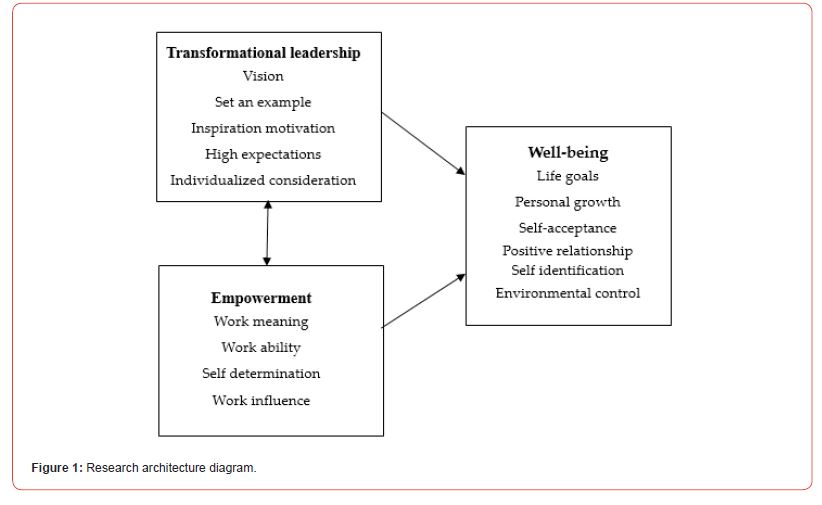
According to the relevant literature, background variables, principal transformational leadership, and teacher empowerment were independent variables, and teachers’ well-being was the dependent variable, as shown in Figure 1. Transformational leadership variables include five behavioral levels: vision, set an example, inspiration motivation, high expectations, and individualized consideration; empowerment variables include work meaning, work ability, self-determination, work influence, etc.; Well-being variables include life goals, personal growth, selfacceptance, positive relationship, self-identification, environmental control, etc (Figure 1).
Participants
In this study, middle school teachers in Taipei City were used as the population, 12 districts were sampled, and 30 questionnaires were distributed in each district. A total of 360 questionnaires were sent out, and 335 questionnaires were returned. After deducting 5 questionnaires with incomplete answers, the total number of valid questionnaires was 330. In terms of sample used precision, the sample size was in line with the estimator [21]. To explore the correlation and impact of principal transformational leadership and teacher empowerment and well-being.
Research tools
This study uses a self-made questionnaire named “Questionnaire on the relationship between principal’s transformational leadership and teachers’ empowerment and well-being” as a research tool. This questionnaire was divided into four parts: background information (including gender, age, position, Teaching Years), Principal Transformational Leadership Scale, Teacher Empowerment Scale, and Teacher Well-Being Scale. The first draft of the research tool was compiled, and the questionnaire was corrected by three university education scholars, and finally the questionnaire was pre-tested. A total of 180 teachers from 6 middle schools in Taipei City were randomly sampled, 172 pre-examination questionnaires were recovered, 7 invalid questionnaires were deleted, and 165 valid questionnaires were obtained.
Principal’s transformational leadership scale: The scale of this study was based on the Multifactor Leadership Questionnaire (MLQ) compiled by Bass and Avolio [22], which includes factors such as vision, setting an example, motivating, high expectations, and individualized consideration. There were 19 items in this scale, which were divided into five factors: 5 items for vision, 3 items for setting an example, 4 items for motivation and encouragement, 3 items for high expectations, and 4 items for individualized consideration. Each item was scored used a fivepoint Likert scale with five options. The higher the score of the total scale of the participants, the more they agree with the principal’s transformational leadership. After the reliability test, Cronbach α=0.87 for vision, Cronbach α=0.84 for setting an example, Cronbach α=0.86 for motivation, Cronbach α=0.83 for high expectation, Cronbach α=0.84 for individualized consideration, and Cronbach α=0.84 for total scale internal consistency coefficient 0.85, indicated that the scale has a considerable degree of internal consistency reliability, so the item was not deleted.
Teacher’s empowerment scale: The Empowerment Scale mainly measures the role and importance of teachers in the schoolwork field. Teachers must have independent judgment and teaching autonomy in the teaching field. Teachers must master teaching progress and effective teaching skills, demonstrate selfefficacy and master closeness. teacher-student relationship. The scale for this study was adapted from Spreitzer’s Psychological Empowerment Scale (PES) [6]. This scale had 12 items, divided into 3 items for work meaning, 3 items for work ability, and 3 items for self-determination. There were four factors including 3 questions and work impact. Each item was scored using a five-point Likert scale with five options. After the reliability test, work meaning Cronbach α=0.86, work ability Cronbach α=0.88, self-determination Cronbach α=0.89, work impact Cronbach α=0.87, and the internal consistency coefficient of the total scale Cronbach α=0.87, showed that the scale had a considerable degree of internal consistency reliability, so the items were not deleted.
Teacher’s well-being scale: Well-being refers to the experience and feeling of self-realization by fully realizing one’s potential. Its connotations include life goals, personal growth, selfacceptance, positive relationships, self-identity, and environmental control. The scale for this study was adapted from the Ryf and Keyes Psychological Well-Being Scale (PWBS) [19], six dimensions, a total of 23 questions, divided into self-acceptance with 4 questions, environmental control with 3 questions, personal There are 3 questions for growth, 4 questions for positive relationships, 4 questions for life goals, and 4 questions for self-identity. Each item was scored used a five-point Likert scale with five options. The higher the score, the higher the level of teacher’s well-being. After the reliability test, life goal Cronbach α=0.87, personal growth Cronbach α=0.83, self-acceptance Cronbach α=0.84, positive relationship Cronbach α=0.85, self-identity Cronbach α=0.86, environment control Cronbach α=0.86, the internal consistency coefficient of the total scale was Cronbach α=0.85, which showed that the scale had a certain degree of internal consistency reliability, so the item was not deleted.
Structural equation model: According to the three scales included in the questionnaire of this study above, the overall Structural Equation Modeling (SEM) was drawn [23], as shown in Figure 2, and list the LISREL analysis symbols of each variable, as shown in Table 1. (Figure 2) (Table 1).
Table 1: Symbol concept of LISREL.

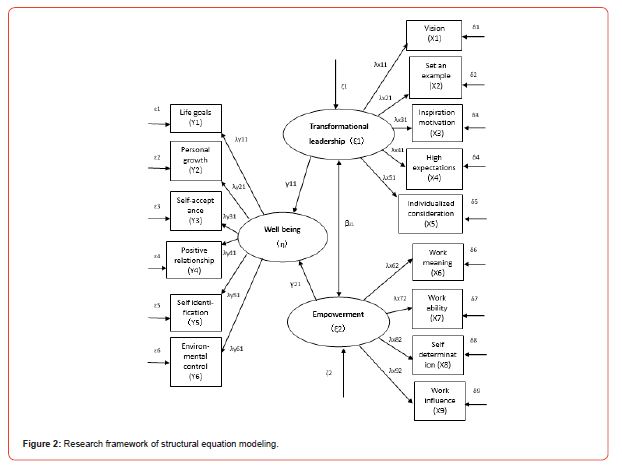
Data Analysis
In this study, SPSS 23.0 Chinese version statistical package software was used for statistical analysis, and the significance level was set at p<0.05. The statistical methods used included descriptive statistics, Pearson’s product difference correlation and structural equation (SEM) test of the variable relationship of the pathway model.
Result
In this study, the relationship between principal’s transformational leadership, teacher’s empowerment and wellbeing was divided into three parts, included the analysis of background variables, the correlation analysis of each scale variable and the path model.
Background variable analysis
This research was based on middle school teachers in Taipei, Taiwan (Mage = 46.22 ± 10.32). A total of 360 formal questionnaires were distributed, and 330 valid questionnaires were obtained after deducting 30 unreturned and invalid questionnaires, with an effective recovery rate of 91.67%. Through a questionnaire survey, to understand the relationship and influence of middle school principals’ transformational leadership, teachers’ empowerment and well-being.
Participants were 144 males (43.6%) and 186 females (56.4%). 25 (7.6%) aged 24-30, 75 (22.7%) aged 31-40, 110 (33.3%) aged 41-50, 80 (24.2%) aged 51-59, 60 aged above (inclusive) there were 40 (12.1%). There were 249 teachers (75.5%) who did not concurrently serve as administrators, and 81 teachers (24.5%) concurrently served as administrators. 23 (7.0%) with less than 5 years of teaching experience, 53 (16.1%) with 5-10 years, 122 (37.0%) with 11-20 years, 78 (23.6%) with 20-30 years, over 30 years (including) 54 (16.4%). Summarizing the background variables of the above participants, most of the teachers were concentrated in the age group of 41 to 50 and have not concurrently served as administrators or teachers with 11 to 20 years of teaching experience.
Correlation analysis of scale variables
The degree of correlation between the variables of each scale was shown in Table 2. Overall, there was a high correlation among the variables (r=0.71~0.86, p<0.01). Further analysis of the relationship between the variables shows that the correlation between teachers’ work ability (empowerment) and personal growth (well-being) was the highest (r=0.86), followed by teachers’ self-determination (empowerment ) and self-identity (well-being) (r=0.85), the meaning of teachers’ work (empowerment) and positive relationship (well-being) (r=0.85), the third was the impact of teachers’ work (empowerment ) and life goals (well-being) (r=0.84). It indicates that middle school teachers’ empowerment was most closely related to teachers’ well-being, and from Table 2, it could be seen that the verification hypothesis 1: there was a significant correlation between principal’s transformational leadership and teacher empowerment and teacher well-being (Table 2).
Table 2: Correlation analysis of principal’s transformational leadership and teachers’ empowerment and well-being.
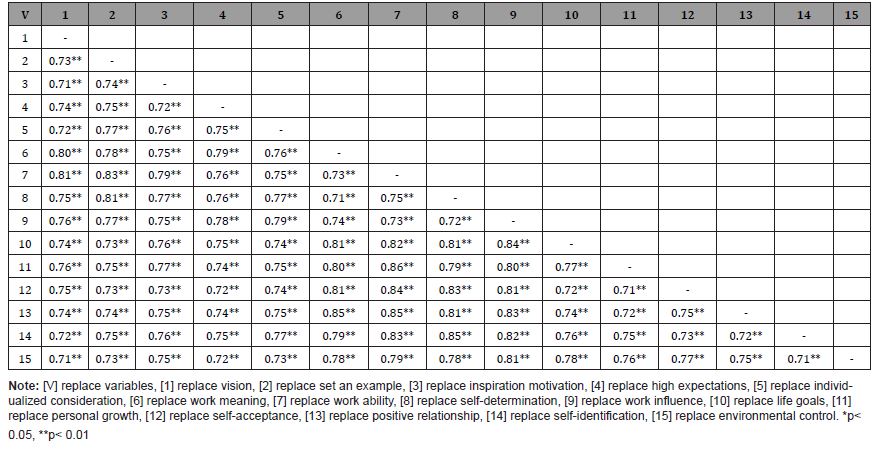
Path Mode
LISREL is a statistical method used to deal with causality. In recent years, LISREL analysis method has received attention in social science and behavioral science. The purpose of this study was to explore the relationship between middle school principals’ transformational leadership, teachers’ empowerment, and wellbeing. Therefore, the causality and verification model were obtained by LISREL. Olsson et al. consider that when the sample was large enough (N>1000), the asymptotic distribution freedom method (ADF) was used to improve the theoretical fit of parameter estimation [24]. However, the sample of this study (N=330) was less than 1000 people, so the maximum likelihood estimation (MLE) is used to examine the observation variables. From Table 3 it was shown that all observed variables were multivariate normal distributions (Table 3).
Table 3: Means, standard deviations and multivariate normal test of observed variables.
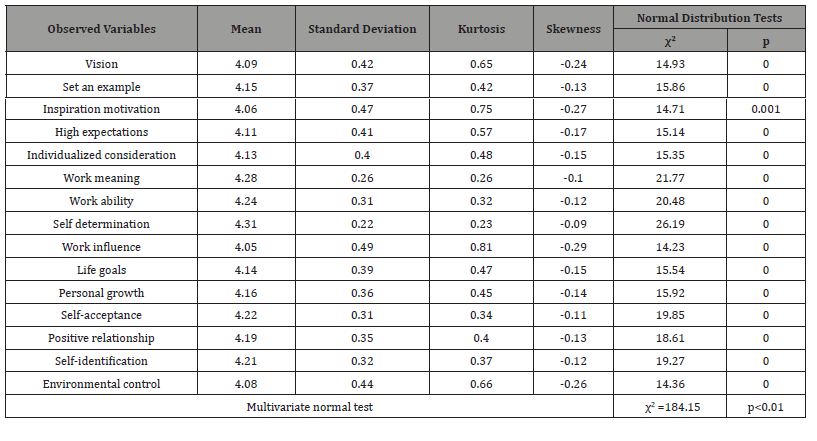
The chi-square fitness test of the model and the observation data reached a significant level, as shown in Table 4, χ2 (df =28, n=330) =184.15, p < 0.01, showed that the null hypothesis that the model fits the observed data was overturned. However, in terms of other fit indicators, the GFI index of this model was 0.94, which meets the verification standard. Second, the SRMR was 0.045, so passing the SRMR should be less than the threshold of 0.08. Furthermore, the ECVI index was 0.68, and the ECVI conformed to the theoretical model must be smaller than the ECVI verification standard of the independent model, which showed that the model had little fluctuation between samples and had good stability. In summary, the fit between the model of this study and the observation data was good. Finally, the RMSEA was 0.01, met the standard that must be less than 0.05, met the standard of the absolute fitness test, showed that the model fits well with the observed data (Table 4).
Table 4: Indicators of overall mode fit.
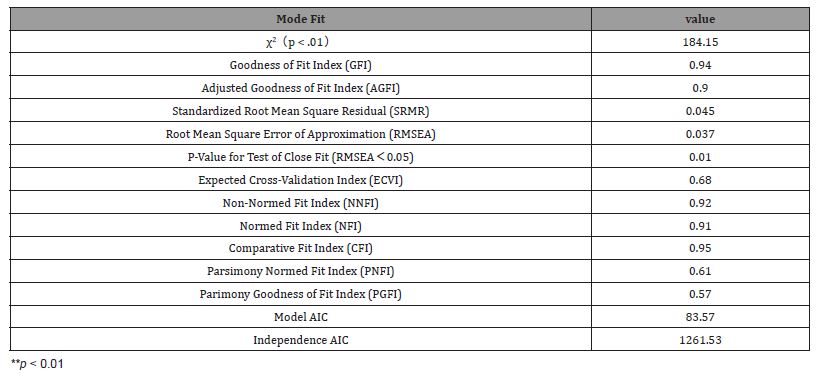
When testing the model estimate, first check whether the observed variable produces an offending estimate. Table 5 showed that the parameter estimate of the observed variable measurement error did not exceed or was too close to 1 (greater than or equal to 0.78). The parameter estimates between latent variables and observe variables did not exceed or were too close to 1 (greater than or equal to 0.83), as shown in Table 6. Parameter estimates among potential variables, as shown in Table 7. It could be seen that the impact of transformational leadership (γ11=0.73) and empowerment (γ21 =0.84) on well-being has reached a significant level, which was in line with theoretical predictions. In addition, the strongest relationship between transformational leadership and high expectations was λ=0.76, the strongest relationship between empowerment and work ability was λ=0.81, and the strongest relationship between well-being and personal growth was λ=0.83. Based on the above construction, the research framework was constructed, as shown in Figure 3. Finally, the hypotheses of this study were verified, that was, transformational leadership had a significant correlation with well-being (γ11=0.73), empowerment had a significant correlation with well-being (γ21=0.84), and transformational leadership had a significant correlation with empowerment (β21=0.78) and verified hypothesis 2: Principal’s transformational leadership and teacher empowerment had predictive power for teachers’ well-being (Tables 5-7) (Figure 3).
Table 5:Parameter estimation of measurement errors of observation variables.
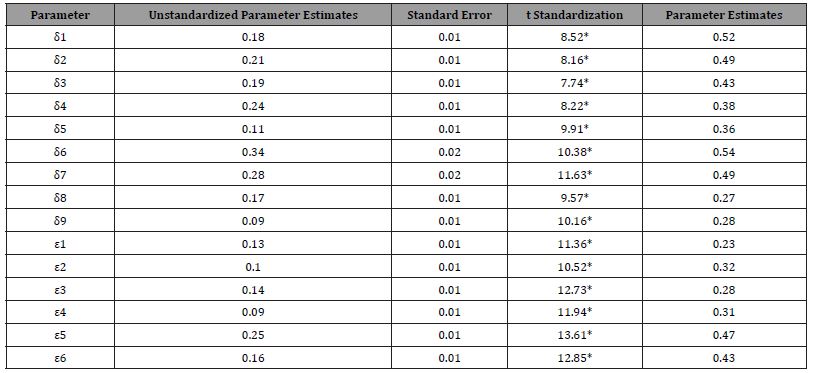
Table 6: Parameter estimation between latent variables and observation variables.
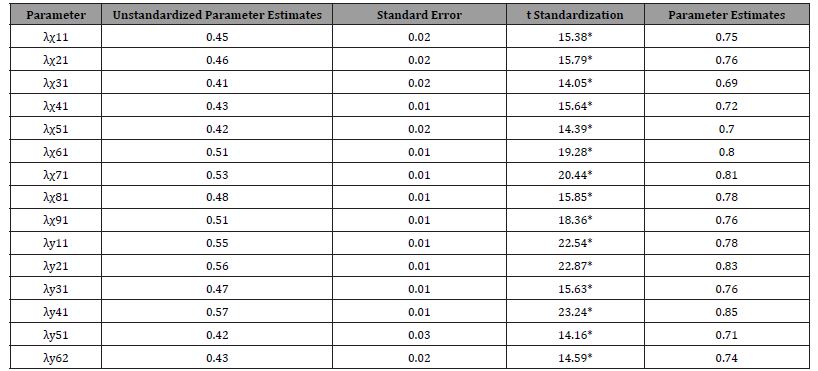
Table 7: Parameter Estimation Among Latent Variables.

Discussion
In order to achieve the success of teachers’ empowerment and well-being, it was of great significance to analyze the factors affecting principal’s transformational leadership from the perspective of teachers. In this study, the focus was on the role of principal’s transformational leadership factors and teacher empowerment on the well-being of middle school teachers in Taiwan. The findings of this study enabled Taiwanese secondary school teachers to identify several important aspects.
First of all, the research results showed that Taiwan has been talking about transformational leadership for 20 years, and most teachers agree with principals’ transformational leadership. Participating in this research was from Taiwanese middle school teachers claiming that the principal would set an example, established a school vision, and have high expectations for the motivation and motivation of teachers, which was consistent with the characteristics of transformational leadership. This phenomenon was consistent with many studies [25-28]. Research has found that principals’ transformational leadership to promote teacher development was a complementary cycle process [29]. This cyclical process means that the principal’s gradual improvement should make it possible to achieve progress and success. At the same time, teachers can also feel the joy of success in this process. The reward of teachers’ happiness is the trust in the principal and the sense of responsibility to the school, thus generating a new impetus for the development of the school [30]. Sharing power was an opportunity for school improvement, means empowering teachers, and means high expectations of the principal for members. Principal’s transformational leadership explains that sharing power means trust and respect and was the best way to motivate members [31,32]. Therefore, the essence of empowerment of the principal’s transformational leadership is to stimulate the enthusiasm of teachers, develop the potential of teachers, and promote the development of the school [33].
The results of this study found that teachers feel high overall psychological empowerment in their work, which means that teachers think that their work was meaningful, believe that they had good abilities in their work, and could make self-determination about their work, they think that they could work in various work decisions were made to achieve desired goals. These traits increase teachers’ psychological empowerment, as has been similar to other research findings [34-38]. However, it should be noted that although teachers express similarly on the four factors of psychological empowerment, the evaluation of “work influence” was relatively poor compared with the other three factors. Among the factors of psychological empowerment, teachers’ evaluation of “work ability” was highest. Research data showed that some teachers in Taiwan who were not part-time administrators did not express well the “selfdetermination” score of psychological empowerments (the lowest score was 2.17, out of 5 points). Thus, participants felt the least empowered in terms of independent decision-making according to the results. This phenomenon also reflects that teachers have an ambiguous awareness of the overall education policy and the direction of school development when making self-determination. These people make independent decisions and choices in the working situation, easily conflict with the development of the school, and feel that their behavior is affected by the school. This is because a small number of teachers are immersed in independent work, ignoring the development of schools and education policies, and cannot have a positive impact on the overall school system [39]. Interestingly, when comparing groups of teachers with different teaching seniority, it was found that there were differences in the expression of teachers’ psychological empowerment. Teachers with higher teaching seniority (over 25 years) feel that the power of “self-determination” was significantly stronger. In addition, teachers who also take up administrative work also have more “selfdetermination”. Future research on this phenomenon investigates this phenomenon in more detail and answers the question of whether these differences reflect the different behavior of principals toward experienced and inexperienced teachers, giving more “self-determination” to older versus part-time administrators power and freedom, or reflect the inner attitude of the teacher, in the case of gaining more and more teaching work experience and the expert experience that comes with it, it enables the teacher to make bolder decisions [40,41]. In addition, scholars pointed out the importance of teachers’ understanding of the school’s vision and development direction to teachers’ psychological empowerment (Kang et al., 2022), which means that the more actively teachers evaluate the principal’s school management goals, it was especially important for teachers’ “work meaning”. The study found that the relationship between principal’s transformational leadership and teacher’s empowerment was 0.78, which means that when principals understand and accept teachers’ emotions, ideas, and values, convey information related to teachers’ work, ask teachers for their opinions, encourage and support teachers, communication between principals and teachers significantly and positively predicts psychological empowerment [42].
The correlation between the working ability of teachers’ empowerment and the personal growth of teachers’ well-being reached 0.86, which was the highest. In addition, overall, teacher empowerment had the highest correlation with teachers’ well-being reached 0.84. In-depth exploration of the reasons, this study found that teachers’ well-being and positive relationship reached a high correlation of 0.85, showed that teachers’ well-being was affected by the interactive relationship between students and parents. In short, the positive relationship between teachers and students could improve teachers’ well-being sense, this result was consistent with many studies [43-45]. It was well known that teachers’ wellbeing affects teachers’ work, and a positive internal environment would ensure that teachers were happy and enjoy their work [46]. Further understand that there was a high correlation between teachers’ empowerment and well-being. When teachers have the right to speak and have opportunities for growth, teachers will be more excited to work and improve teaching quality. It also shows that teacher empowerment can produce positive well-being [47,48].
Studies have pointed out that reduced the pressure on teachers from the external environment (parents care about students’ performance) and improved interpersonal relationships could bring joy to teachers. Because teachers reduced obstacles and maintained enthusiasm in the workplace, it would increase teachers’ sense of well-being and willingness to put in the work [49]. Research indicated that when teachers feel well-being, they were enthusiastic about being creative, presenting activities and tasks in the classroom, and their teaching outcomes likewise affect learner success [50]. In addition, teacher optimism was important because teachers were viewed as role models that students imitate and play a considerable role in students’ learning process [45,51]. Optimistic behavior by teachers can enhance student motivation and help students see problems from different perspectives and deal with them effectively even in difficult situations [52]. Teachers’ optimistic behavior is manifested in gratitude, empathy, self-care, tolerance, hope, and enjoyment, that is, teachers’ optimistic attitude has an important relationship with teachers’ well-being [53].
Based on the above, the principal’s transformational leadership and teachers’ empowerment had positive predictive power on teachers’ well-being. Among them, the four factors of “vision”, “set an example”, “work meaning” and “work ability” had positive predictive power for “ Well-being” had the greatest impact. As for the internal influencing factors of teachers’ well-being, they were most affected by “positive interpersonal relationship” and “personal growth”. The above factors, whether external or internal, were highly positively correlated with teachers’ well-being [54,55]. Finally, it was worth discussing the limitations of this study. The cross-sectional design of this study made it possible to assess the correlation between principal’s transformational leadership and teachers’ empowerment on teachers’ well-being, but the participants were from middle school teachers in Taipei, reduced the generalizability of the results. Therefore, it was recommended to choose a longitudinal study design in future studies, considering some objective or observable variables [56].
Conclusions
The principal’s transformational leadership was related to teachers’ empowerment and well-being and had a predictive effect. There were few previous studies on the three topics, which could be said to be innovative research. The conclusions of this study were divided into three points. 1. In terms of the principal’s transformational leadership: Middle school teachers believed that it was important for the principal to be a role model, and they value the principal’s own working ability. 2. In terms of empowerment: Middle school teachers believed that empowerment depends on the teacher’s own work ability, and the teacher’s work ability was affected by the continuous growth of the individual. 3. Teachers’ sense of well-being: Middle school teachers believed that maintaining positive interpersonal relationships could achieve the best sense of well-being. Finally, this study focuses on the impact of principal’s transformational leadership and teachers’ empowerment on teachers’ well-being. The results of the research can give primary and secondary school principals the ability to adapt to local conditions, take appropriate leadership actions can empower teachers, build positive teacher-student relationships, and improve well-being.
Funding
The authors have no funding for any research relevant to their study.
Institutional Review Board Statement
The study was conducted according to the guidelines of the Declaration of Helsinki and approved by the institutional review board.
Informed Consent Statement
Written informed consent was obtained from participants to participate in the study.
Data Availability Statement
The experimental results obtained real data, and study participants before and after the measurement data obtained through after training. Participants agree with the data structure via a confirmation, and confirmation can be disclosed reasonable availability. All datasets on which the conclusions of the paper rely are available to editors, reviewers, and readers.
Acknowledgment
The authors appreciate the fitness center of the National Taiwan College of Performing Arts for providing us with the opportunity and facility to research the topic. Moreover, we thank all participants for actively participating in the experimental courses and following independent exercises.
Conflicts of Interest
The authors declare no conflict of interest. This manuscript has not been published elsewhere and it has not been submitted simultaneously for publication elsewhere.
References
-
Wang Kuang-Chung and Wu Cheng-En*. Research on the Relationship Between Principal’s Transformational Leadership, Teachers’ Empowerment, and Teachers’ Well-Being. Iris J of Edu & Res. 1(1): 2023. IJER.MS.ID.000503.
-
Principal’s transformational leadership, Teacher’s well-being, Empowerment, Self-determination, Self-identification, Environmental control, Work influence, Self-acceptance, Psychological empowerment scale
-

This work is licensed under a Creative Commons Attribution-NonCommercial 4.0 International License.






